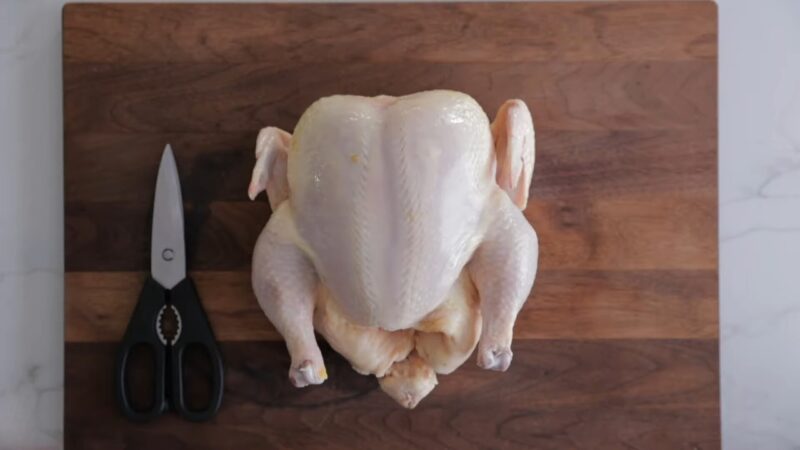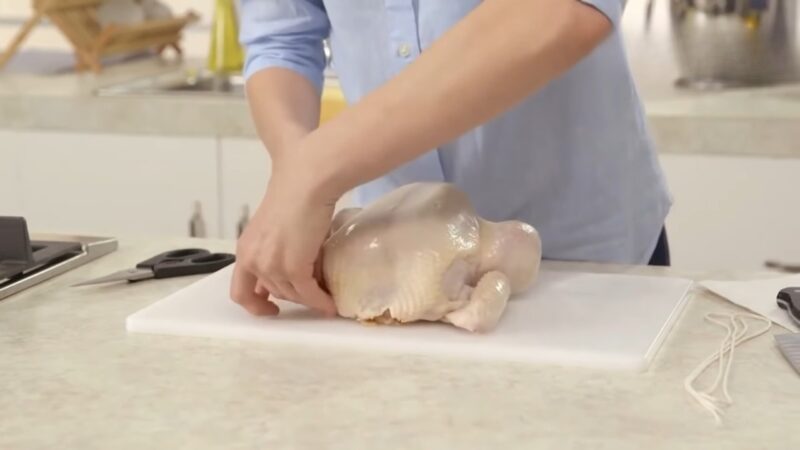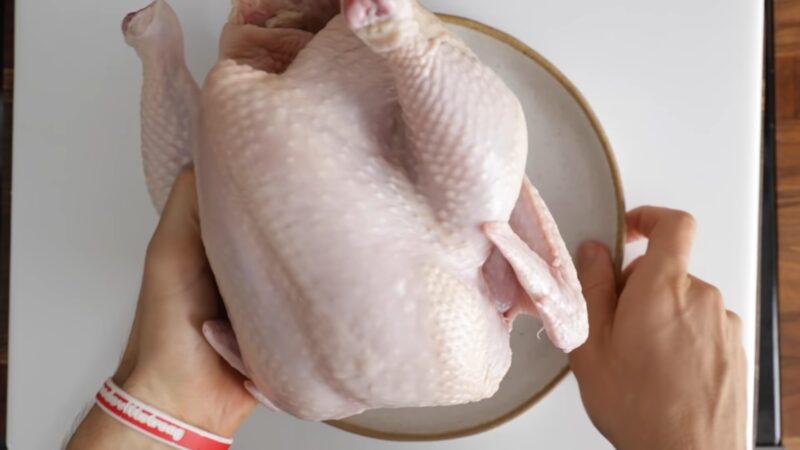Ever opened a package of chicken, only to be hit with an unexpected and unpleasant aroma? I have, and it’s an experience I won’t soon forget.
It was a sunny Saturday, and I had planned to make a comforting chicken stew for dinner. As I began prepping, I tore open the plastic wrap of the meat I had just bought the day before. Instead of the familiar, neutral scent of fresh chicken, I was greeted with an off-putting smell that immediately made me question the safety of my meal.
I’ll just say that I didn’t eat chicken for quite some time. After this, I started to explore the reasons behind it and whether it was safe to eat this meat. Join me as I share what I’ve learned, hoping to save you from a similar odor shock.
Natural Scent of Chicken

All meats have their unique scent, and chicken is no exception. Fresh meat typically has a light, subtle smell. Some describe it as a “faintly sour” scent, but this doesn’t mean it’s gone bad. However, if the chicken has a potent or offensive odor, it’s a sign that something might be wrong.
It’s essential to differentiate between its natural scent and an off smell that indicates spoilage.
Factors Affecting the Smell
Several factors can influence the way the meat smells:
- Feed it consumed
- Conditions it was raised in
- How it was processed
For instance, free-range chickens might have a slightly different scent than those raised in commercial settings due to their varied diets and environments.
Additionally, the packaging can also affect the smell. The meat that’s been vacuum-sealed might have a more potent scent once the package is opened, but this should dissipate after a few minutes.
Signs of Spoilage
Chicken that’s gone bad will exhibit several signs. The most obvious is a strong, sour smell. This is due to the growth of bacteria and other microorganisms. If the meat smells like rotten eggs or sulfur, it’s best to throw it away.
Other signs include a slimy or tacky texture. Fresh meat should feel moist but not slimy. If you touch it and it feels sticky or leaves a residue on your hands, it’s a clear sign of spoilage.
The Role of Color in Determining Freshness
While smell is a primary indicator of a chicken’s freshness, its color can also provide clues. Fresh meat should have a pinkish hue. Over time, as it starts to spoil, it might turn gray or greenish. However, color alone isn’t a definitive sign.
Factors like the chicken’s age, its diet, and the way it was processed can all influence its color. Always use a combination of smell, texture, and color to judge its freshness.
If you’re curious about different preparation methods that can enhance the flavor and aroma of your chicken, learning how to smoke chicken wings can be a delightful experience.
Safe Storage Practices

Proper storage can significantly extend the shelf life of your meat, ensuring it remains fresh and safe to eat.
Refrigeration vs. Freezing
Refrigeration is suitable for short-term storage. If you plan to cook the meat within a day or two of purchasing it, keeping it in the fridge is ideal.
For longer storage periods, freezing is the way to go. Freezing halts the growth of bacteria, ensuring the chicken remains safe for consumption.
When you’re ready to use the frozen meat, it’s essential to thaw it correctly. The best method is to transfer it from the freezer to the refrigerator and let it thaw slowly. Avoid leaving it out at room temperature, as this can encourage bacterial growth.
Importance of Packaging
How you package your meat for storage can also influence its shelf life. Air is the enemy when it comes to storing meats. If you’re freezing chicken, consider using vacuum-sealed bags. These remove most of the air and ensure the meat remains fresh for longer.
In the fridge, make sure the meat is wrapped tightly, either in its original packaging or in a sealed container. This not only prevents the chicken from absorbing other odors in the fridge but also reduces the risk of cross-contamination.
What Are the Reasons Behind the Spoilage?

1. Bacteria and Microorganisms
At the heart of chicken spoilage are bacteria and microorganisms. Raw chicken naturally contains bacteria, including Campylobacter and Salmonella. In proper storage conditions, their growth is minimal. However, when the meat is left out or stored improperly, these bacteria multiply rapidly.
The waste products from these multiplying bacteria are what give the spoiled meat its off-putting smell. It’s nature’s way of warning us that something isn’t right.
2. Oxygen
Oxygen plays a crucial role in chicken spoilage. Many spoilage bacteria are aerobic, meaning they require oxygen to grow. This is why vacuum-sealed packaging, which removes most of the air, can extend the shelf life of the meat.
By limiting the oxygen available, you’re inhibiting the growth of these spoilage bacteria.
The Role of Chicken’s Diet and Rearing

The conditions in which a chicken is raised and its diet can influence its overall quality, taste, and smell.
Free-Range vs. Factory-Farmed
Free-range chickens often have access to outdoor spaces, natural light, and a varied diet. This can result in a slightly different taste and smell compared to factory-farmed chickens, which are often raised in confined spaces and given a uniform diet.
The varied diet and natural environment of free-range chickens can sometimes result in a more “gamey” aroma.
For instance, the distinct flavor of free-range chicken can elevate dishes like Authentic Halal Cart-Style Chicken.
The Impact of Feed
The feed given to chickens can influence their taste and smell. For instance, chickens fed a diet high in a fish meal might have a faint fishy aroma. On the other hand, chickens fed primarily on grains might have a milder, more neutral scent.
Health Implications of Eating Spoiled Meat

Consuming spoiled chicken isn’t just about facing an unpleasant taste; it can have serious health implications.
Food Poisoning and Its Symptoms
Eating spoiled meat can lead to food poisoning, caused by bacteria like Salmonella or Campylobacter. Symptoms can range from mild to severe and include nausea, vomiting, diarrhea, abdominal pain, fever, and muscle aches.
These symptoms can start as soon as a few hours after consumption or take up to a few days to manifest.
Long-Term Health Risks
While most cases of food poisoning resolve on their own, severe cases can lead to complications. Dehydration is a common concern, especially with symptoms like vomiting and diarrhea.
In rare cases, certain strains of bacteria can lead to more severe conditions, such as kidney failure or even death. It’s essential to seek medical attention if symptoms are severe or persistent.
2 Tips for Buying Fresh Chicken

Prevention is better than cure. By ensuring you buy fresh meat, you can avoid many of the issues associated with spoilage.
Check Expiry Dates
Always check the expiry or “sell by” date when purchasing chicken. While these dates aren’t foolproof indicators of freshness, they give a general idea of how long the meat has been on the shelf.
Assess the Packaging
Inspect the packaging for any signs of damage, such as tears or holes. Damaged packaging can expose the meat to contaminants. Additionally, if the package is bloated or has excessive liquid, it might be a sign that the meat is past its prime.
FAQs

Can I Use the “Sniff Test” as the Only Method to Determine if Chicken Is Still Good?
While the “sniff test” is a valuable tool in determining the freshness of the meat, it shouldn’t be the sole method. Combining it with visual checks for color and texture, as well as checking the expiry or “sell by” date, provides a more comprehensive assessment.
How Long Can Raw Chicken Be Left Out of the Refrigerator Before It Becomes Unsafe to Eat?
Raw chicken should not be left out at room temperature for more than 2 hours. In hotter environments (above 90°F or 32°C), this time reduces to just 1 hour. Bacteria multiply rapidly at room temperature, increasing the risk of foodborne illnesses.
Is It Safe to Wash Raw Chicken Before Cooking?
This practice is not recommended. Doing so can spread harmful bacteria to other foods, utensils, and countertops through splashing water. Cooking meat to the recommended internal temperature of 165°F (74°C) is sufficient to kill any harmful bacteria.
Can I Refreeze Chicken that Has Been Previously Thawed?
It’s generally safe to refreeze the meat that has been thawed in the refrigerator and hasn’t been left out for extended periods. However, there might be a slight loss in texture and moisture due to the freezing and thawing process.
Why Does Some Chicken Have a “White Striping” Appearance?
White striping refers to white lines or streaks running parallel to the muscle fibers in chicken meat. It’s believed to be a result of modern farming practices where chickens are bred to grow rapidly.
While it can affect the texture and fat content of the meat, it’s not a sign of spoilage or a health concern.
Can Cooking Spoiled Chicken Make It Safe to Eat?
While cooking can kill many of the bacteria present in spoiled chicken, it won’t eliminate toxins produced by some bacteria during the spoilage process. Consuming meat that has toxins can still lead to food poisoning.
It’s always best to avoid cooking and consuming the meat if you suspect it’s spoiled.
Summary
Ensuring the safety and quality of the chicken you consume is a combination of various factors, from buying to cooking. Your senses are powerful tools. If something smells off or looks questionable, it’s always better to err on the side of caution – it’s not worth risking your health for a piece of meat.
While this guide has focused on chicken, many of the principles apply to other meats and perishables. Being informed and vigilant about food safety can prevent illnesses and ensure that your meals are not only delicious but also safe.

